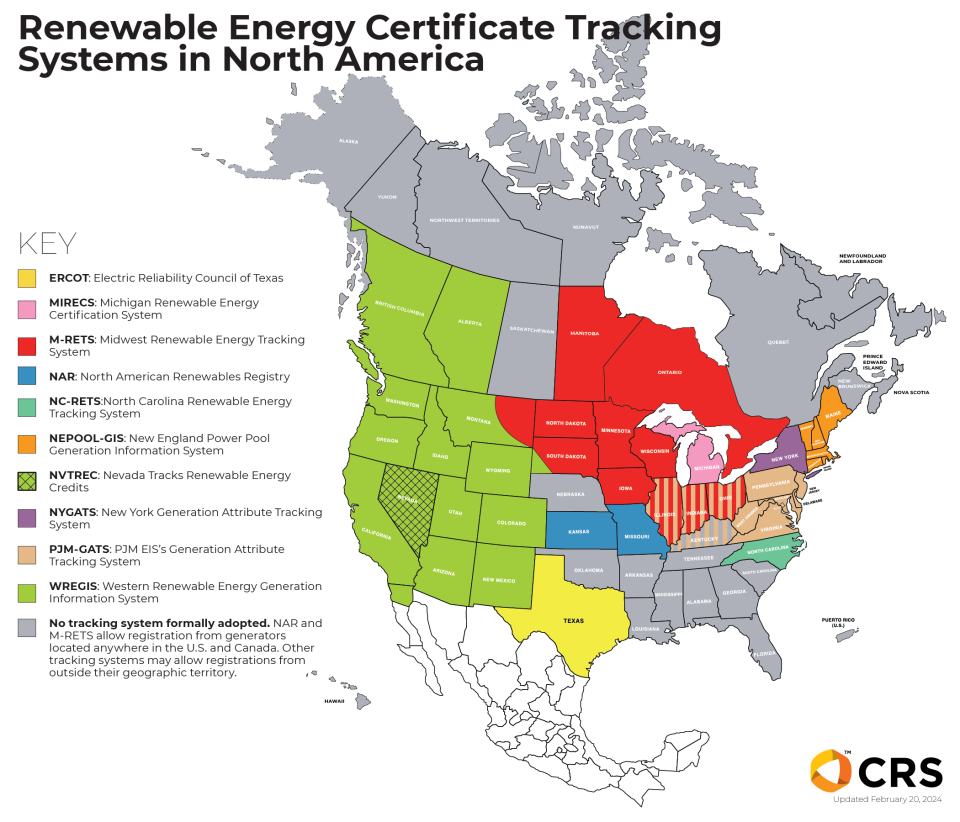Energy Attribute Tracking Systems
How is renewable energy tracked in the United States?
There are two accepted approaches for tracking renewable electricity and its ownership in U.S. energy markets:
Certificate-Based Tracking Systems
Certificate tracking systems account for Renewable Energy Certificates (RECs) and ensure that RECs are only held by one organization. These tracking systems are typically electronic databases that register basic information about each megawatt-hour (MWh) of renewable generation in a specific U.S. geographical region (see map). They issue renewable energy certificates (RECs) to the generator, signifying that a MWh of renewable electricity has been delivered to the grid. (Several U.S.-based tracking systems register and track generation from all resource types, and not just renewable generation. These are referred to as “all-generation” tracking systems.)
Electronic tracking systems allow RECs to be transferred among account holders, similar to how currency is transferred within our online banking system. Tracking systems assign a unique identification number to each REC to ensure that only one REC is issued for each MWh of generation reported, to avoid ownership disputes and minimize double issuance. As such, a uniquely identified REC can only be in one tracking system account (i.e., owned by one account holder) at a time.

Source: CRS :https://resource-solutions.org/wp-content/uploads/2018/02/Tracking-System-Map.png
Each REC issued by the tracking system includes specific information on the renewable energy attributes that it represents.
Visit the Renewable Energy Certificates webpage for more information.
Regulators also use tracking systems as a registry of eligible generating facilities and as a means of verifying compliance with state renewable portfolio standards; for aiding in the creation of electricity disclosure labels; and for other purposes, such as verifying wholesale supply for green power products.
Tracking systems are not substitutes for third-party certification and verification, as tracking systems only monitor wholesale transactions—individual retail green power customers generally do not hold accounts on tracking systems and thus cannot participate directly through this mechanism. RECs that are destined for sale in retail energy markets generally make their way through several wholesale intermediaries or brokers until they are sold to retail electricity suppliers, who in turn sell them to an eventual end-consumer. To learn more about third-party certification and verification, please visit the certification and verification webpage.
Tracking systems are emerging as the preferable method for tracking wholesale renewable energy because they can be highly automated, contain specific information about each MWh and are accessible over the Internet to market participants.
Contract-Path Tracking Method
The contract-path method of tracking and tracing renewable energy is widely used and is the oldest method utilized in the market to verify, track and trace the chain of custody of renewable energy ownership from a generator to the end consumer.
Generally, a buyer's green power portfolio mix is the sum of its energy supply contracts. The contract-path approach consists of a third-party audit supported by declarations, sworn statements, contract receipts, and other proof of generation and transfer of ownership (e.g., between a generator, intermediary, or final marketer) to the ultimate end consumer. Metered generation data are often used to support and verify such attestations and supply contracts.
The cost of contract-path accounting is usually borne by an intermediary supplier or end consumer. Fees for such auditing services in the United States can vary widely. Buyers of retail renewable electricity should seek, as a best practice, suppliers that sell independently certified and verified green power products. End -consumers that purchase third-party certified and verified green power products can be assured that the green power they are buying has been found to meet nationally accepted standards for product quality, that their purchase is supported by renewable energy supply contracts that meet the retailer's advertised product, and that their purchase is uniquely their own (not double counted). To learn more about third-party certification and verification, please visit the certification and verification webpage.
